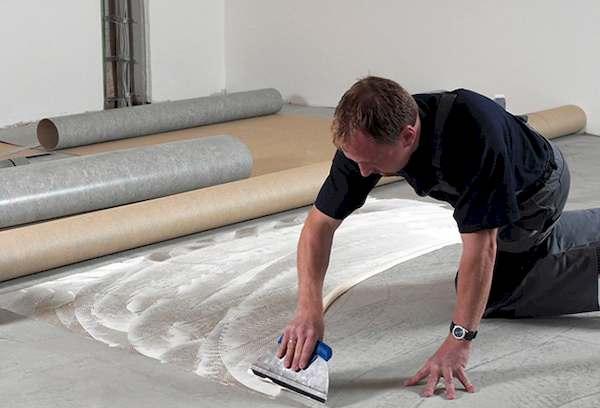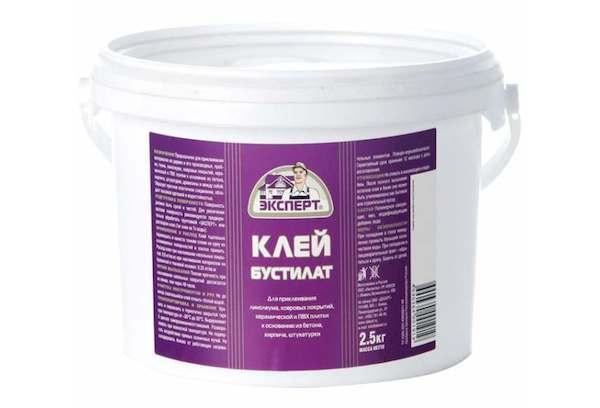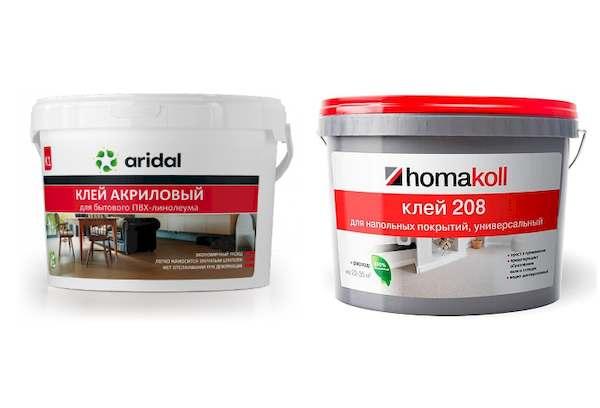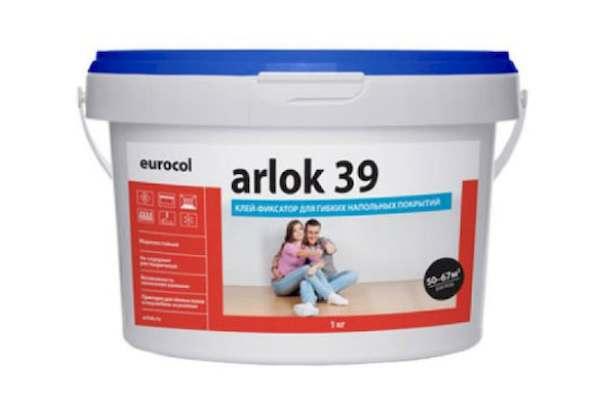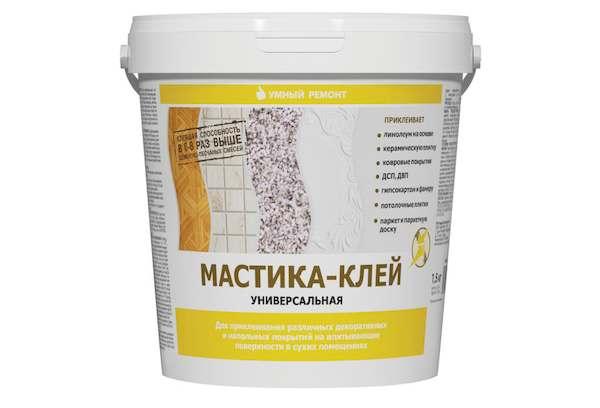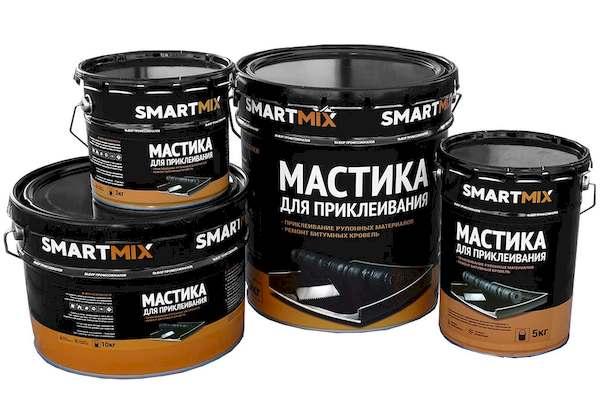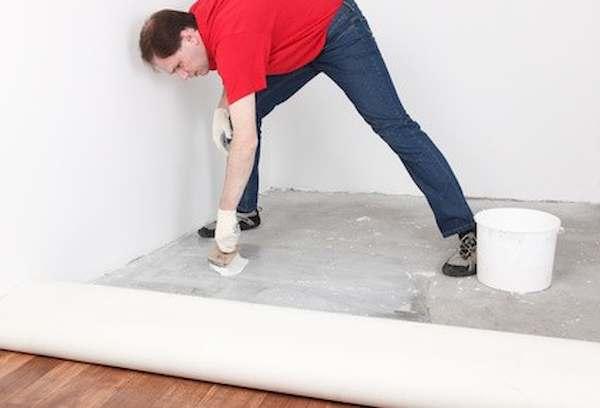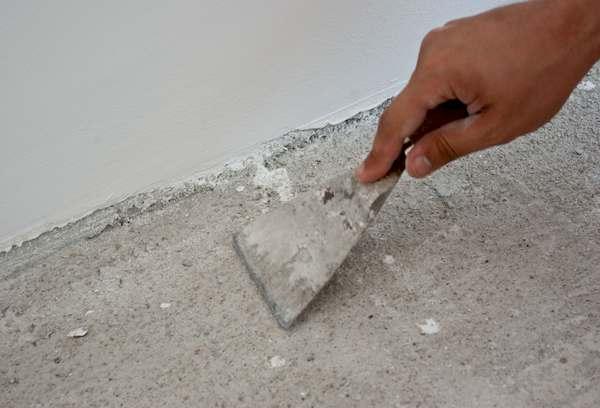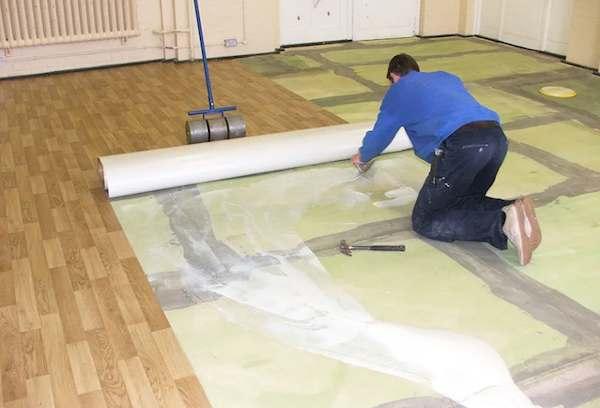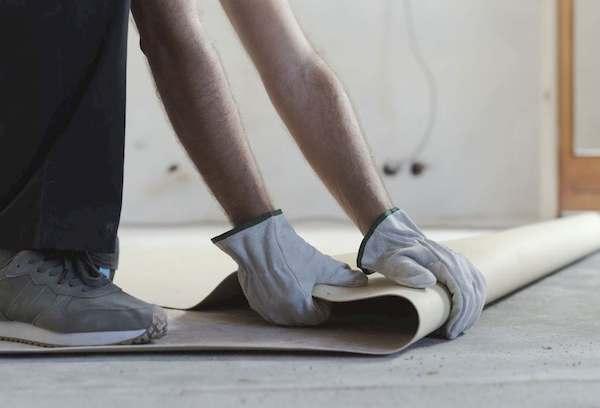How and with what to glue linoleum to a concrete floor: types of glue and step-by-step gluing of linoleum to concrete
Content:
According to building codes, linoleum must be laid using the adhesive method, using special glue for linoleum. Water-dispersion mastic and, less commonly, other adhesives are applied to the concrete floor. It is important that the adhesive composition is suitable for the linoleum base and the absorbent base. Brands of adhesives that are very popular among professionals and ordinary users: TYTAN Professional, Arlok, Axton, Homakoll 208.
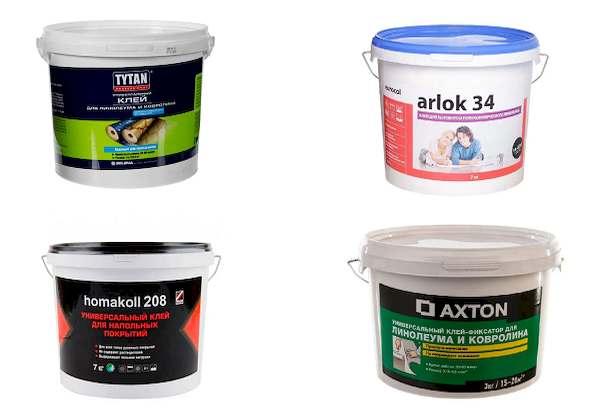
Is it necessary to glue linoleum to a concrete floor, and why?
There are different ways to lay linoleum on a concrete floor. Each method has its advantages and disadvantages, and is selected based on operating conditions.
- Without attachment to the surface. The simplest and most budget option. It is used mainly for small rooms up to 12 square meters. meters with low traffic.For example, for storage rooms and bedrooms. To avoid waves, the canvas is allowed to rest and then fixed with thresholds and baseboards. The disadvantage of this method is the high risk of deformation of the coating when moving furniture. Waves and folds may appear on linoleum. In the future, these places will wear out faster.
- Fixation with double-sided tape. This is possible provided that the concrete floor is smooth and has a primed surface. The method is not very popular, since you need a lot of adhesive tape and it is not cheap. It is more profitable to attach the canvas with glue.
- Bonding to concrete. For spacious rooms, rooms with high traffic, this is the only correct way. Laying with glue requires certain costs, but provides the best wear resistance of linoleum. The glued coating does not bend with waves and remains even and smooth for decades. It's harder to damage. There is only one significant disadvantage to this method - it is more difficult to dismantle glued linoleum.
- Laying linoleum on concrete treated with a fixative. Retainers, or fixations, have become popular relatively recently. They turn the base into Velcro. After this, linoleum sticks well to the concrete. It doesn't move, but it can be easily removed.
What adhesive materials should I use?
First of all, the choice of adhesive for linoleum depends on the material from which the coating is made. If it is linoleum based (felt, jute, foam), they are guided by it. The material of the front part does not play a big role.
Particular attention is paid to:
- Is the glue suitable for natural linoleum or only for synthetic;
- Is it possible to apply glue to an absorbent base (concrete).
When choosing an adhesive composition, you also pay attention to the conditions under which you can work with it.For unheated rooms, special glue is needed. The next important selection criterion is technical characteristics, such as strength, setting speed, and additional functions.
- For computer rooms, telecommunication centers, and electronics factories, it is recommended to use conductive or current-dissipating linoleum. It also requires a special glue - with conductive ability.
- For gyms, cafes, and canteens, commercial linoleum and glue with high mechanical load are used.
- For installation in an unheated room and for making linoleum applications, a heavy-duty and frost-resistant adhesive is required.
Types of glue for linoleum on concrete floors
You can glue linoleum to a concrete floor using 3 types of adhesives:
- Dispersion adhesives (water-based). They are environmentally friendly and suitable for children's rooms and other constantly heated rooms. They do not emit toxic fumes during operation, and can have different adhesion strengths. These adhesives contain water-soluble acrylic, latex or resins. Well-known representatives of the group: Bustilat, Gumilax, Acrylate glue. The first has a latex-chalk base, elastic, and saturates artificial and natural felt well. Humilax is quite viscous, does not contain solvents, and provides strong fixation. It is well suited for linoleum on jute, and natural “marmoleum”. The base of Gumilax is rubber. Acrylate glue is highly viscous, suitable for jute and synthetic fibers. Recommended for medium-traffic rooms.
- Contact adhesives (universal). Such adhesive compositions have the best adhesion and are suitable for cases where the floor is subject to significant loads.Contact adhesive can be used if you need to lay the coating over a wall, on steps, curved and inclined surfaces, in a room with high humidity, unheated or poorly heated. The composition is usually applied on both sides. Representatives of the group: contact adhesive for linoleum and carpet Homakoll, ARIDAL K4.
- Fixation (adhesive fixation). It is used primarily for laying expensive household and semi-commercial brands of linoleum. It's not really glue. Fixation is a polymer mixture that is applied to the surface like a primer. Once dry, it forms a sticky film that feels like the sticky side of tape. Linoleum with any base, including felt, sticks well to it. In this case, linoleum can be peeled off and glued back up to 5 times. There is only one downside to fixation - the high price. A popular representative is Arlok 39.
Mastics for gluing linoleum
The name “mastic” itself comes from a Greek word. Mastic was the name given to the resin of the mastic tree, used in perfumery, cosmetology and fine arts. Today, mastic is a chemical used for various construction works.
Mastics for gluing linoleum are often dispersive adhesive compositions with a viscous consistency. Bitumen mastics provide 100% waterproofing, but are not suitable for all materials, only PVC.
- To securely fix the fabric onto a fabric base, bitumen mastic can be used.
- For linoleum without a base, mastic made from synthetic rubber or bitumen is used.
- If there is a thermal insulation base, dispersion mastic is used.
For better bonding of surfaces, a primer prepared from the selected mastic is often applied to the concrete floor. It is diluted with water (dispersive) or gasoline (bitumen, rubber), and the base is covered. After the primer has dried, the linoleum is glued.
Bitumen mastics for gluing linoleum are:
- Bitumen-rosin. Contains resin from coniferous trees. Originally developed for gluing fabric-based linoleum to concrete.
- Bitumen-latex. They apply well with a spatula, do not drag on the tool, and can be distributed in a relatively thin layer. They set quickly and are suitable for use in unheated areas.
- Rubber-bitumen (Biski, Izol). Explosion-proof, unlike other types of bitumen mastics. But they gain strength for a very long time, within a month.
Prepare the glue yourself
You can make mastic for gluing linoleum yourself. Homemade adhesives are suitable for PVC linoleum without a base or with a fabric base (bitumen-chalk, cement-chalk). Recipes:
- Cement mastic – 140 g of casein glue, 450 g of grade 500 cement, 450 g of water. Soak the glue in warm water and let it swell for half an hour. Add cement and stir until smooth. The composition can be used for 3-4 hours, approximate consumption is 2 kg per 1 sq. meter.
- Cold bitumen mastic - 25 kg of bitumen grades BN-50/50, BN-111, petroleum bitumen, 1 kg of rosin, 7 liters of gasoline. Melt the bitumen and heat to 180 degrees. Add rosin, stir. Cool to 80 degrees, pour in gasoline and stir. Store in a container with a stopper. Can be used at any convenient time (expiration date is unlimited). Consumption – 1-1.5 kg per 1 sq. meter.
- Bitumen-chalk mastic – 2 parts BN-70/30 bitumen, 2 parts chalk, 1 part gasoline. Melt the bitumen and cool to a temperature of 80 degrees. Pour in gasoline. While stirring the mixture, add chalk in small portions. Use the mixture within 4-5 days.
- Cement-chalk – 1.5 parts chalk, 0.5 parts cement, 1 part drying oil. Combine chalk with cement. Pour in drying oil and mix. The composition is suitable for use for 2-3 days. If the mastic has thickened, you can dilute it with drying oil.
Attention! The mastic should be homogeneous, elastic, without lumps or clots.
Glue installation technology
The technology for gluing linoleum to the floor may differ depending on the materials used. The general principle is as follows:
- Fold half of the fabric bottom up.
- Measure the lapel size.
- In accordance with the measurements, draw a boundary for applying glue on the concrete base.
- Apply adhesive to the floor using a notched trowel or roller.
- Wait the time specified in the instructions for the glue you are using.
- Unfold the canvas and lay it on the treated surface.
- Smooth out the linoleum first by hand, and then roll it lengthwise and crosswise with a roller. According to the technology, the roller should weigh 50 kg.
- Glue the second part of the canvas in exactly the same way.
- Protect the coating from stress until the adhesive material has completely hardened (on average, 5 days). During this time, you cannot bring furniture or place other heavy objects into the room. It is advisable not to walk on linoleum.
Important! The adhesive composition cannot be applied in a thick layer. The canvas won't hold up any better. On the contrary, the glue will dry much longer than indicated in the instructions and may become lumpy.
Conditions for performing work
Most adhesives work in room conditions.The conditions for performing the work are as follows:
- Air humidity up to 75%.
- The room temperature is above 18 degrees.
- The maximum humidity of a concrete floor is 2-5%.
- The base temperature is 15 degrees.
Necessary tool
To lay and glue linoleum to a concrete base, you will need construction tools:
- straight iron ruler;
- sharp knife with replaceable blades;
- adhesive composition with instructions for use;
- notched trowel (A1, A2) or structural roller for uniform application of glue;
- heavy roller for leveling canvases;
- the linoleum itself;
- baseboards or decorative moldings in a matching shade.
Preparatory stage
To ensure that the linoleum does not go into “waves” and sticks evenly and efficiently, you need to spend several days preparing.
The preparatory stage includes:
- Cleaning and drying the base. All debris, dust, old glue, and greasy marks are removed from the floor. After wet cleaning, time is given for drying.
- “Acclimatization” of linoleum and glue. You need to bring the materials into the room and leave them for several days so that they warm up to the room temperature.
- Trimming to room shape and tracking. It is advisable to roll out the linoleum on the floor and leave it to rest and level for 2-3 days. However, you cannot put anything heavy on it.
If several canvases are intended to be connected, they are laid out with an overlap of 2-10 cm, taking into account the pattern. The same reserve is needed along the walls.
It is allowed to glue linoleum only to a clean, dry, and always flat and strong base.
Step-by-step instruction
Before applying glue, you should decide whether the linoleum will be glued entirely or only in places.If the canvas is thin, without a base, continuous application of the adhesive is recommended. Rigid linoleum base, with a foam layer, semi-commercial, can be partially fixed to concrete in an apartment. In this case, the glue is applied in strips, in a grid or along the walls.
Step-by-step instruction:
- Carefully read the instructions for the glue.
- Prepare the glue for use: stir if necessary, prepare a solution or connect the components.
- Lift the spread linoleum and bend it to the middle of the room.
- Apply glue to the base or to the base and the bottom layer of the canvas (if so indicated in the instructions) using a notched trowel or structural roller.
- Allow the composition to dry for about 5 minutes (see the packaging for the exact drying time).
- Lay the linoleum smoothly, being careful not to create air bubbles.
- Walk on a heavy shaft.
- At the joint, cut off 2 layers of material using a sharp knife and a metal ruler. Clean the seams from any scraps.
- Clean the joint from any escaping adhesive and press down with a weighted board.
- Trim the aligned and glued sheets, leaving thermal compensation gaps of 5-30 mm at the walls. After gluing the linoleum, they will be hidden under the baseboards.
Instructions for gluing household linoleum
The most inexpensive type of linoleum is household. It is used in apartments and private houses in rooms with low load (bedrooms). The thickness of the canvas varies from 1 to 3.5 mm, and the protective layer does not exceed 0.3 mm.
The best way to lay household linoleum is by gluing it with dispersion glue.
- It is recommended to apply the adhesive composition in a continuous layer.
- For linoleum with a smooth base, latex-based glue is used, for linoleum with a fleecy base, Bustilat M is used.
- The recommended layer of adhesive mass is 0.5-0.6 cm.
- The adhesive is applied to the floor using a notched trowel.
- The use of such glue is possible only at room temperature.
A Guide to Commercial Linoleum
Commercial linoleum is intended for installation in rooms with intense load: educational institutions, cinemas, offices, shopping centers, etc. It is not afraid of intense pressure, friction, and chemicals. The abrasion class of the coating is 31-34, and the thickness of the protective layer is 0.7 mm. “Commerce” is denser, more durable, but also significantly more expensive. However, such linoleum is often purchased for apartments for the kitchen and hallway. Then the question arises, what and how to glue it?
In commercial premises, dispersion mastics are used. Video:
For use at home, it is possible to lay commercial linoleum without glue. Due to its greater density and heaviness, it rarely comes in “waves,” provided that the base is level and the canvas has been properly rested. Another option is to glue the decking with adhesive applied in strips or mesh.
Questions and answers
Do I need to somehow treat the concrete floor to glue linoleum?
Manufacturers recommend laying linoleum on a solid base. A concrete floor is ideal for this purpose, provided it is level, strong and clean. A height difference of no more than 5 mm per two meters of length is allowed. In this case, there should be no protrusions, and only smooth pits are allowed. If the concrete is lumpy or there are significant differences in height, pour a leveling screed.
A small number of protrusions are removed by grinding. Depressions are sealed with repair mortar. If the screed is expanded clay concrete, it is recommended to cover the floor with a primer so that dust does not appear and the glue holds securely. Also, soil is used if the screed is not new and dusty.The primer helps reduce the absorbency of concrete and, accordingly, the consumption of glue. Leveling and processing of the concrete base is carried out at least 7-10 days before laying the linoleum.
How to glue linoleum joints to a concrete floor?
The joints of linoleum are additionally treated with special “Cold Welding” glue. It reliably connects the canvases to each other, is waterproof, quick-drying, and durable. Processing does not take much time, does not require special skills and can be done on your own. For new linoleum, liquid cold welding for Type A PVC with a needle tip is used.
At the junction, an overlap of 6 cm is made between the sheets in order to cut two sheets at once. Then the seam is as smooth as possible. Wide masking tape is applied to the joint to protect the surface from excess glue. It is then cut directly above the seam. A needle nozzle is inserted into the slot and filled with cold welding. After half an hour, the masking tape is removed. After this, the coating can be used. But it is recommended to fully load it, wash it, place furniture no earlier than after 24 hours.
The adhesive method of laying linoleum can increase its wear resistance and strength. For large rooms with high loads, such fastening is the only way to avoid waves and swelling from moving furniture. On average, gluing linoleum increases its service life by 50%. The choice of adhesive composition depends on the characteristics of the selected coating. When purchasing linoleum, it is important to ask about them. You can contact a consultant to select the appropriate glue, and then proceed according to the instructions on the package.
